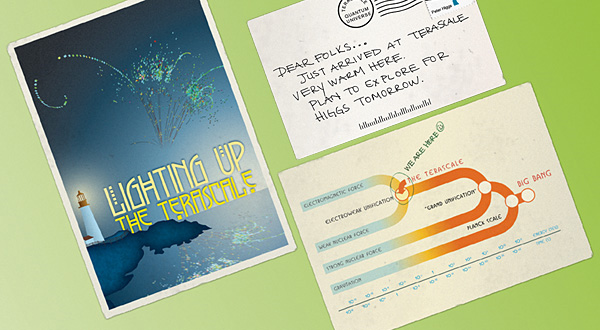Postcards from the terascale
by Judy Jackson
In February, the Department of Energy's Office of Science and the National Science Foundation asked the High Energy Physics Advisory Panel "to form a committee to write a document" that addresses the synergies and complementarities of the Large Hadron Collider, now under construction at CERN, and the proposed International Linear Collider. The report, to be published in early fall 2005, will describe the role of the next generation of particle accelerators in addressing the key questions of particle physics today. As the report will make clear, the answers to many of these questions seem to lie in still-undiscovered phenomena at a range of very high energies called the Terascale, a scientific terra incognita that the next generation of particle accelerators will explore.

|
The sun warms planet Earth, but the temperature in the surrounding universe is only three degrees above absolute zero. Its energy is so low that we can no longer see what space contained in the inferno of its birth. As the universe cooled from the big bang, it passed through a series of phases, each at a lower energy and each with its own set of particles and forces acting according to its own physical laws.
Particle accelerators give us the opportunity to go back and revisit the higher energies of our ancestral universe, to observe phenomena no longer visible in our own era. These high-energy phenomena matter to us, because our universe today still feels their imprint. The order behind what appears arbitrary in our own universe becomes clear at higher energies.
For example, many theories predict that at the extreme energy just after the big bang all of nature's forces were combined in one single unified force, which split into the four forces that we know today as the universe cooled. By reconnecting to the early universe, we may learn how gravity connects to electromagnetism as different aspects of a single principle of nature.

|
Since the first cyclotrons of the 1930s, particle accelerators have been our passports to higher and higher energies. Our entire picture of the structure of matter, with its fundamental particles and forces, has emerged from the increasing energies of particle collisions. Each generation of accelerators has built on the discoveries of previous generations to take us deeper into the mystery and beauty of the universe.
Now, a new generation of accelerators with the highest energies yet will open up for exploration a region of energy—the Terascale—that has ten thousand trillion times the energy of space today. By taking us to this new scientific territory, these will allow us to discover the quantum universe. Postcards from the Terascale will answer basic questions at the heart of particle physics.
Moreover, the Terascale is not the end of the story. Discoveries there may reveal phenomena occurring at scales of energy so high that no particle accelerator will ever achieve them directly. Such postcards from the Planck scale once seemed an unreachable fantasy. Forwarded from an address in the Terascale, they may one day arrive.
Click here to download the pdf version of this article.






